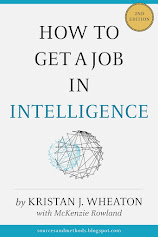Part 9 -- Departures From The Intelligence Cycle
Part 10 -- The New Intelligence Process
One of the most pervasive themes to emerge from this study of the intelligence cycle and, more importantly, its critiques, is that the intelligence process needs to be seen generally, as part of a larger decisionmaking process, and specifically, as something that has its own, unique, functions.
Trying to merge these two aspects of the process, one macro and holistic and the other micro and specific, seemed to me to be too much to ask of one diagram so I have split my understanding of the intelligence process into two pictures.
It is worth asking at this point: Why does the intelligence process need a picture at all? Why not just use simple, straightforward words? Beyond the demonstrated psychological value of images in helping people understand complex topics, whatever replaces the intelligence cycle will also have to replace the image of the intelligence cycle. I see no realistic alternative to fighting fire with fire.
It might also be worth asking, if you are going to use two, why not more? Why not a dozen? Why not a hundred pictures? I recognize the risk of proliferating images. In the anti-PowerPoint sentiments prevalent among many of today's leaders, more pictures may well be viewed as more clutter. In response, I can say that I have been using the two pictures I will propose over the next several posts in my classes, in my project work and in a number of meetings with senior decisionmakers for several years now. The response has been very positive.
The first picture (See below) defines the general relationship between intelligence and operations and with the decisionmaker that they both support. It is very clear (or should be, by now) that the intelligence process cannot be viewed in a vacuum. If it is correct to talk about an “intelligence process” on one side of the coin, it is equally important for intelligence professionals to realize that there is an "operational/planning process", just as large if not larger and equally important if not more so, on the other side.
These two sides overlap in significant ways, particularly with respect to the purpose, goals and people of the organization. The intelligence professional is, however, focused externally and attempts to answer questions such as “What is the enemy/criminal/competition up to?” and “What are the threats and opportunities in my environment?”
The operational side of the coin is more focused on questions such as "Where will we place our police/military forces?", “How will we train our forces/employees?” or "What plans do we need to create to be prepared for likely contingencies?" In many ways, the difference between operations and intelligence is the difference between "we" and "they" and the fundamental intelligence question is “What are they likely to do?” while the fundamental operational question is “What are we going to do?” Embedded in this distinction is also the difference between an estimate and a recommendation.
It is from this shared vision of the organization’s purpose and goals that intelligence requirements emerge. With few exceptions, there does not seem to be much concern among the various authors who have written about the intelligence process about where, exactly, requirements come from. While most acknowledge that they generally come from the decisionmakers who have questions or need estimates to help them make decisions, it also seems to be appropriate for intelligence professionals to raise issues or provide information that was not specifically requested when relevant to the goals and purpose of the organization. In short, there seems to be room for both “I need this” coming from a decisionmaker and for “I thought you would want to know this” coming from the intelligence professional as long as it is relevant to the organization’s goals and purposes.
Theoretically, at least, the shared vision of the goals and purpose of the organization should drive decisionmaker feedback as well. The theoretical possibility of feedback, however, is regularly compared with the common perception of reality, at least within the US national security community, that feedback is ad hoc at best.
There, the intelligence professionals preparing the intelligence are oftentimes so distant from the decisionmakers they are supporting that feedback is a rare occurrence and, if it comes at all, is typically only when there has been a flaw in the analysis or products. Some intelligence professionals have gone as far as to claim that “There are only intelligence failures and policy successes” suggesting that intelligence is often a convenient whipping boy for poor decisions while intelligence rarely gets credit for the eventual decisionmaker successes.
It is questionable whether this perception of reality applies throughout the intelligence discipline or even within the broader national security community. Particularly on a tactical level, where the intelligence professional often shares the same foxhole, as it were, with the decisionmaker, it becomes obvious relatively quickly how accurate and how useful the intelligence provided actually is to the decisionmakers.
While most intelligence professionals subscribe to the poor feedback theory, most intelligence professionals also have a story or two about how they were able to provide intelligence to decisionmakers and how that intelligence made a real difference, a difference willingly acknowledged by that decisionmaker. The key to this kind of feedback seems less related to the issue or to intelligence writ large and more related to how closely tied are the intelligence and decisionmaking functions. The more distance between the two, the less feedback, unsurprisingly, there is likely to be.
*****
While this first picture might be a new way of representing the relationship between intelligence, operations and decisionmaking, the content of this image is unlikely to be surprising to most intelligence professionals. Understanding the content of this image is truly basic stuff -- Intel 101.
Which is precisely why it is so important to capture it in an image and to give it equal visual weight with the more specific image of intelligence I will discuss in the next post. This first picture, in short, is not for the seasoned professional. It is for the student and, more importantly, for the decisionmaker.
Few decisionmakers, outside the military, have any formal experience integrating intelligence into their processes. Elected officials, CEOs and chiefs of police typically have an image of intelligence informed mostly by Hollywood. They may well see intelligence as connected to the rest of their organization by a dotted line (or, in extreme cases, by no line at all).
This image, then, sends a powerful message to these decisionmakers. It tells them that, whatever they may have thought about intelligence, it is really about understanding those things that are relevant to your success or failure but are outside of your control. All decisionmakers, no matter how obstinate, will eventually agree that knowing the enemy is as important as knowing yourself, that intelligence and operations are really just different sides of the decisionmaking coin, and this picture helps get them to that point. Once they have made this cognitive leap, it is much easier to convince them to integrate (and appreciate) the specific functions of intelligence.
Next: The Second Picture







